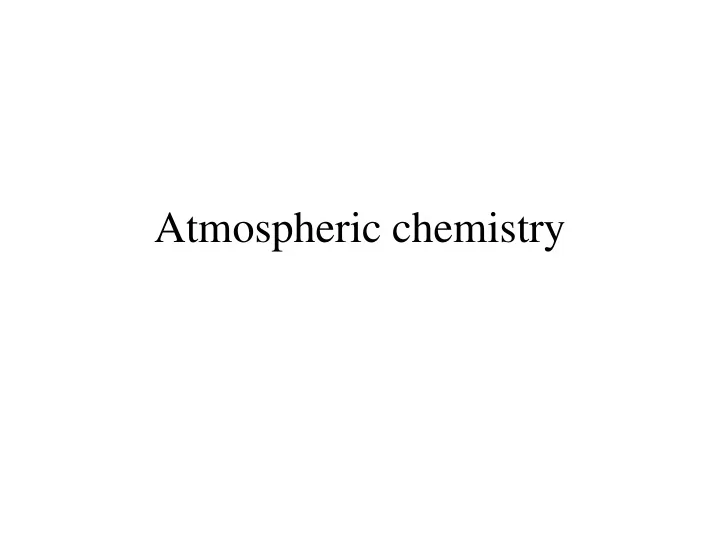

Atmospheric chemistry
Atmospheric chemistry • Set of Reactions that happens in the atmosphere. • The atmosphere is an oxidizing medium • Most of reactive species in the atmosphere became from radiation reaching the earth.
Reactions • Formation of breaking of bonds (or both) – A+B AB – A C + D – A+ BC AB + C – … • Bonds are formed when 2 electrons are shared between two atoms.
Electronegativity
Electronegativity • All atoms want to be like a noble gas == have a close shell (8 electrons) • If they have few electrons the will want to give those, if the have a may they will want to take them.
Forming bonds
Forming bonds
Forming bonds
Polar bonds
Breaking bonds • Different bonds have different energies. • Energy of O-O 2 bond in Ozone is 150 KJ/mol • Energy of O-NO bond in NO 2 is 300 KJ/mol • If we want to break a bond we nee to give at least that energy to it.
Charge • Excess or defect of electrons in a molecule
Radicals • Molecules with an odd electron (or 2, bi-radicals) • They are extremely reactive, the are represented using · in front of the molecule • ·OH, ·NO3…
What is radiation? • Radiation is energy transmitted by electromagnetic waves; all objects emit radiation • One refers to electromagnetic waves equivalently as photons, representing quantized packets of energy with zero mass traveling at the speed of light • We use “electromagnetic waves” to stress the wave nature of radiation and “photons” to emphasize its quantized nature
Energy of photons • E = hν = h c / λ – Where h is the Planck constant , c is light speed and lambda is the wave length • Using that expression we can calculate the energy of the photon depending on the wavelength – 700 nm 170 KJ/mol – 530 nm 230 KJ/mol – 420 nm 280 KJ/mol – …
Atmospheric photochemistry • When a photon collide with a molecule A, the molecule reach an excited state – A +hv A* • Molecule A may release the energy excess in different way: – Dissociation A* B+C – Reaction A*+B C+D – Fluorescence A* A + hv – Collision A* + M A + M – Ionization A* A + + e -
Quantum yield • Defined for each process • Ratio of the number of molecules A* that follows that process • So, the sum of the quantum yields for all possible process must be 1 • Is a function of wavelength
Photolysis • To calculate de rate of photolysis we need to know the photons absorbed by molecule A. • This amount is given by absorption cross section of A, σ A (λ) • So, if we multiply the absorption cross section by the number of photons that reach the molecule and the concentration of A – σ A (λ) I (λ) d (λ) [A] • But photolysis is not the only process, so we have to include quantum yield of photolysis ( ϕ A ) – ϕ A (λ) σ A (λ) I (λ) d (λ) [A] • The Photolysis rate J A will be the integral over Lambda
Actinic Flux What is I(λ )? • The photon flux from ALL directions • The actinic flux is determined by the solar radiation entering the atmosphere and by any changes in this due to atmospheric gases and particles (e.g. Rayleigh scattering A absorption by stratospheric ozone, scattering and absorption by aerosols and clouds), and reflections from the ground. It is therefore dependent on the wavelength of the light, on the altitude and on specific local environmental conditions.
Actinic flux
Absorption cross section
Quantum yield
Oxidizing atmosphere • The main oxidants in the atmosphere are – OH radical (·OH) – Ozone – Nitrate Radical (·NO 3 )
The OH radical: main tropospheric oxidant Primary source: O 3 + hv O 2 + O( 1 D) (1) O( 1 D) + M O + M (2) O( 1 D) + H 2 O 2OH (3) Sink: oxidation of reduced species CO + OH CO 2 + H Major OH sinks CH 4 + OH CH 3 + H 2 O HCFC + OH H 2 O +… GLOBAL MEAN [OH] = 1.2x10 6 molecules cm -3 and a lifetime of about 100 ms Earths surface, 30º N D.J. Jacob
Tropospheric OH production takes place in a narrow UV window (300-320 nm) 30 equinox midday Solar spectrum D.J. Jacob
O( 1 D) h ν HONO HCHO H 2 O NO O 3 NO h ν HNO 3 OH HO 2 H 2 O 2 + O 2 NO 2 HO 2 CH 4 HCHO H 2 SO 2 RO 2 H 2 SO 4 RO 2 + O 2 VOC CO NMHC O 3 RO 2 (Boy et al., ACP, 2005)
Formation of HO 2 Radical HCHO + hv ·H + HCO ·H+O 2 +M ·HO 2 +M HCHO + hv H 2 + CO CO + ·OH CO 2 + ·H ·H+O 2 +M ·HO 2 +M
Formation of Sulfuric acid • SO 2 + ·OH + M ·HOSO 2 + M • ·HOSO 2 + O 2 ·HO 2 + SO 3 • H 2 O + SO 3 + M H 2 SO 4 + M
Monoterpenes oxidation by OH radicals
Recommend
More recommend